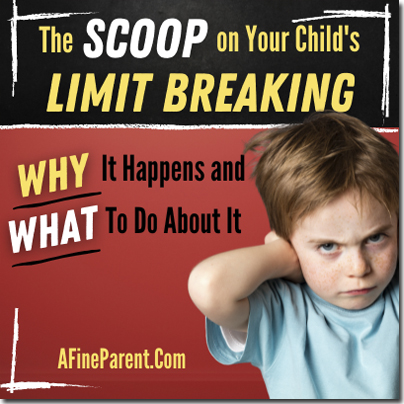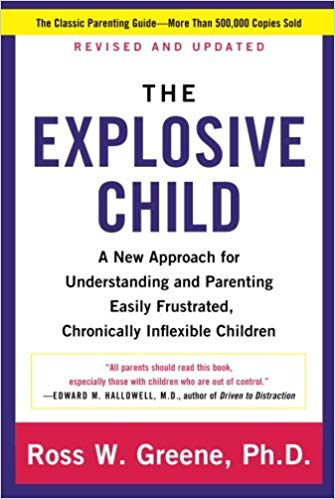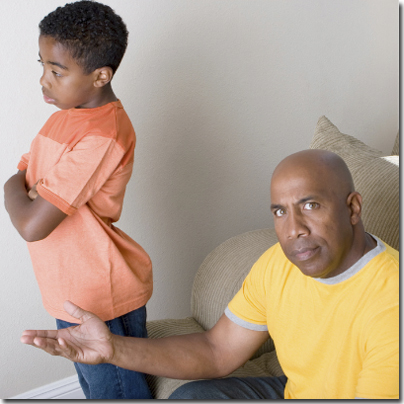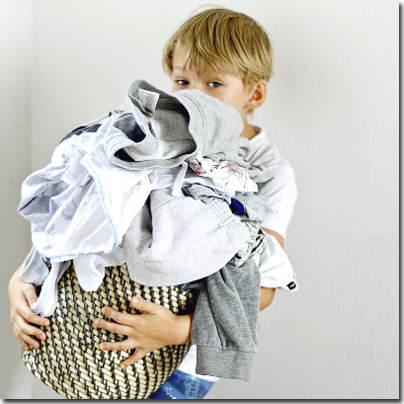 Not too long ago I realized that I had to do something differently when dealing with my child’s limit breaking. After one particularly intense “episode,” I could no longer ignore the fact that I was in a pattern of caving to my daughter’s demands, simply as a means of avoiding the full-blown tantrum.
Not too long ago I realized that I had to do something differently when dealing with my child’s limit breaking. After one particularly intense “episode,” I could no longer ignore the fact that I was in a pattern of caving to my daughter’s demands, simply as a means of avoiding the full-blown tantrum.
These behavior episodes would occur every time I tried to enforce limits. If I attempted to follow through with the limit that had been set, the entire family would pay for hours. What had begun with the occasional rule breaking had quickly spun out of control and become a repeated, every day occurrence.
All children break limits occasionally; after all, testing limits is a way to experiment with independence. And while frustrating, it can actually be healthy for children to test boundaries, as the brain develops and a child begins to recognize the cause and effect their actions can have on the world around them.
It is when our children argue with everything we say or break the same limit repeatedly (such as with my daughter), that we can really begin to question what we could do differently. We may begin to feel like our children are making intentional, irresponsible choices, especially when they ignore our guidance over and over again. While we can celebrate their independence in decision making, we also want them to make the “right” choices!
How do we know when limit breaking moves beyond what is developmental normal and healthy? Take a couple of minutes to answer these questions (honestly!):
- Do I find myself in a power struggle about a broken limit at least once a day?
- When I attempt to follow through on a limit, does it often take 30 minutes or more for my child to be able to move on?
- Do I often feel like I’m making “exceptions” to limits for the sake of avoiding a power struggle?
- When I attempt to stand firm on a limit does it result in behaviors that are disruptive to the day?
- Do I (or the rest of my family) often feel like we need to tiptoe around set limits in order to avoid a power struggle, argument, or meltdown?
- Does my child’s limit breaking often toe the line (or cross the line) of unsafe or unhealthy behavior?
If you answered yes to any or all of these questions, your child is likely struggling with breaking limits and it may be time to revamp how you set limits AND how you react to limit breaking. Keep reading for the scoop on limit-breaking and the 3 steps we can take to understand why it’s happening and what we can do about it.
Step 1: Consider Their Skill Set
 In The Explosive Child, Dr. Ross Greene, Ph.D, sheds light on why some children have a more difficult time with breaking limits–and it’s probably not why you think. Dr. Green explains that behavior issues may occur when children don’t possess the skills needed to behave differently.
In The Explosive Child, Dr. Ross Greene, Ph.D, sheds light on why some children have a more difficult time with breaking limits–and it’s probably not why you think. Dr. Green explains that behavior issues may occur when children don’t possess the skills needed to behave differently.
Skills take time and experience to develop; we should not expect that telling a child about a certain limit will automatically resonate with them. The key to learned behaviors is repeatedly giving our children opportunities to practice the behavior. Children must utilize skills over and over again before they can begin to apply them independently.
 Does your child’s difficult behavior often leave your head spinning? We partnered with Dr. Ross Greene, clinical child psychologist, college professor, and best-selling author, to better understand how behaviors may be a window view into our child’s skill deficits.
Does your child’s difficult behavior often leave your head spinning? We partnered with Dr. Ross Greene, clinical child psychologist, college professor, and best-selling author, to better understand how behaviors may be a window view into our child’s skill deficits.
This packed masterclass is one of the 70+ masterclasses you get when you join the AFineParent Academy today. Click here to learn more.
If we pay close attention to the situations in which limit breaking arises and the cues our child gives us before and during, we can likely gain some recognition of the skills they may be lacking. For example, in situations that require problem solving, a child who does not yet possess efficient adaptability skills may not be able to find an acceptable way to solve a problem and may then fall back on problem behaviors.
I noticed this when I stepped back to access the root causes of the struggles of my own daughter. I realized that I had gotten into the habit of being a helicopter parent. I solved all her problems for her when she was young, sheltered her from the need to adapt to anything, consistently allowed her to be the boss of the household, and did not ask her to be accountable.
If the car was in the shop, I called an Uber so she wouldn’t have to take the bus. When a family member expected her to help out with cleaning up, I would step in and do the work for her. I always did everything in my power to ensure she didn’t have to adapt to anything new or face any challenges whatsoever.
There is a necessary balance between helping our children and allowing them to face difficult situations. Without the opportunity to face these situations, my daughter failed to learn the skills necessary to adapt to challenges. She entered adolescence not knowing how to problem solve.
Any time I attempted to set a limit, a power struggle ensued and most often, I succumbed for the sake of what was easier or what would “keep the peace” for the rest of the family. It took some hard work, but she is now learning those skills and our day to day life is no longer a power struggle.
Step 2: Consider What the Behavior is Communicating
 ALL human behavior has purpose behind it. Think about it for a minute: we make the choice to exercise so that we can stay healthy and live longer. We make the choice to work so we can have money to support our families or to have access to the things we want. We may turn on the TV to watch a show in order to avoid taking out the trash.
ALL human behavior has purpose behind it. Think about it for a minute: we make the choice to exercise so that we can stay healthy and live longer. We make the choice to work so we can have money to support our families or to have access to the things we want. We may turn on the TV to watch a show in order to avoid taking out the trash.
Our child’s limit breaking behavior also holds a purpose and in order to end the cycle, parents must first investigate the reasons behind the behavior. I found this out the hard way, as I continuously tried strategies that failed miserably until I was able to pinpoint the why behind the behaviors.
As we consider our child’s behaviors, we will want to think about these possible messages that our child may be communicating:
- I’m tired
- I need more routine or structure
- I’m thirsty or hungry
- My food or diet is off
- I’m sick or in pain
- I need more exercise or fresh air
- I’m overstimulated or understimulated
- I need less screen time
- I have fears and worries about something
- I’m struggling at school with learning
- I don’t understand
- I’m having trouble expressing emotions
- I’m feeling shame about something
- I have a lack of confidence
- I’m having trouble dealing with a big life change
- I’m lacking a skill needed
- I’m testing a limit
- I want more independence
- I want to feel more in control of something
- I need more positive attention or one-on-one time
- I’m dealing with an underlying developmental disability or mental health issue
Children are not always able to communicate with their words, but their behavior can often give clues as to what’s really going on. In observing my own daughter’s behaviors, I slowly began to recognize that they often appeared to be during times in which my attention was on her sibling. I realized that she craved more attention from me and once I began spending more quality time with her and began reacting to her with concern and love rather than frustration and anger, her behavior improved drastically.
Step 3: Make a Plan of Action
How we react to our child’s behavior in the moment AND what we do outside of the moment can impact and help change limit-breaking behavior. While we can guide and empower children to follow set limits, we cannot ensure completely that they will. We do, however, have complete control of our own reactions and behavior.
As children learn from watching those around them (especially their parents), positive modeling is an invaluable and reliable method we can use to steer the situation in the desired direction. Read on to find out more about how we can be a positive model and how we can make a plan of action for addressing limit breaking:
#1: Stay Calm & Don’t Take it Personally
 While it may seem cliche, the importance of managing our emotions during a power struggle cannot be ignored. This can be easier said than done in the heat of the moment! Frustration may take over and we suddenly find ourselves in a shouting match with our child.
While it may seem cliche, the importance of managing our emotions during a power struggle cannot be ignored. This can be easier said than done in the heat of the moment! Frustration may take over and we suddenly find ourselves in a shouting match with our child.
When our children are breaking limits, it’s important to be serious but calm. This may not necessarily ensure that our child responds in a calm manner, but it will help prevent the situation from escalating further. Remaining calm and nonreactive can help our children follow suit and can assist in situations where attention is being sought (as it decreases the negative attention given).
Imitation as a form of learning is especially effective for younger children; but even when a child is older it can be quickly calming for an emotionally heightened child to hear a low, even tone. Some other ways of staying calm when things get heated include:
- lowering our voice and moving closer (rather than addressing limit breaking from across the room).
- getting at eye-level and making eye contact. Putting phones and devices down.
- keeping a neutral tone of voice and facial expressions.
- passing a notebook back and forth and writing to each other instead of yelling.
- for older children, communicating via text message.
- giving some space (for both parent and child) before beginning a decision about what happened.
These techniques help by reducing or eliminating yelling, saying things that will be regretted later, and getting sucked into the vortex of a power struggle. While it may take some trial and error to figure out what works best for each child, these small changes in how we react can help our child maintain a calmer state of mind; which in turn opens the door for more productive communication.
#2: Choose Words Wisely
 When things get heated, it can be easy to use words that may do more harm than good. While it’s okay to let your child know you are unhappy or even disappointed, it can be counterproductive to express actual anger to a child; it may result in adding fuel to the fire! Concern and empathy are likely more productive emotions to portray when speaking with a child about their behavior.
When things get heated, it can be easy to use words that may do more harm than good. While it’s okay to let your child know you are unhappy or even disappointed, it can be counterproductive to express actual anger to a child; it may result in adding fuel to the fire! Concern and empathy are likely more productive emotions to portray when speaking with a child about their behavior.
I know how difficult this can be. I was one of those moms yelling at my child, so angry that she would intentionally do things she knew were against the rules. Of course I was concerned for her and it was most often the concern that made me angry. I subconsciously choose to show the anger rather than my concern for her well being.
It’s important that we avoid saying things that may make our children feel that they are “bad.” There are never bad children, just bad behaviors! The way we talk to our children can have a great impact on their self-esteem and their future ability to follow directions.
It may be helpful to emphasize a negative behavior with the action rather than the child. Instead of telling our child they are bad, explain that the behavior is bad. For example, instead of telling a child who is breaking a limit by hitting someone else by saying, “that’s bad,” we could instead say, “hitting is bad.”
Additional phrases and statements we should take care to avoid and the statements we could replace them with include:
- Instead of “Why would you do that?” say, “I’m concerned for your safety.”
- Instead of “What’s wrong with you?” say, “If something is going on, I’d like to help.”
- Instead of “You never listen!” say, “I’m here to listen.”
- Instead of “I’m done!” say, “Let’s find a better way together.”
Once I made the decision to show only concern and empathy, regardless of how heated things got, I began to see an amazing difference. My daughter became much more accepting of the limits I had in place and broke them much less often. It was amazing that such a small difference could make such a big impact!
#3: Involve Our Child in Limit Setting
 When limit breaking is the result of a need for control, compromise and choices can be powerful weapons. Compromising on less important issues can be a good way to balance a need for control with appropriate boundaries. Depending on the ages of our children, we may want to let them have control over:
When limit breaking is the result of a need for control, compromise and choices can be powerful weapons. Compromising on less important issues can be a good way to balance a need for control with appropriate boundaries. Depending on the ages of our children, we may want to let them have control over:
- The clothes they wear (as long as they are weather appropriate, who cares if they match)
- Staying up later (10 minutes left of their movie? Let them finish it)
- Coloring their hair (Hair chalk is a good alternative to dyes)
- Meal time (four pieces of broccoli instead of five won’t stunt their growth)
I have had to make such compromises with my own child. It has allowed her to feel she has some control during situations she’d normally balk at. We have compromised on which days during the week she should clean her room and how many hours should be allocated for video games; both areas in which there is much less likelihood of argument now!
We all have limits we aren’t willing to compromise on. Sitting down with our child and involving them in the process of setting limits can be very beneficial, as it allows for better understanding of expectations and gives some sense of control to the child. Children are less likely to break limits they have some ownership of.
Working together to create the family rules also has secondary benefits of quality time spent together and the sharing of a common goal. Children who have access to regular “connection” time with parents and whose “attention bucket” is filled on a normal basis are less likely to break limits.
Having a hard time deciding where to start with involving your child in limit setting? Some key areas that may be good to try include:
- Bedtime: Routines, pajamas, bedtime stories, even bath time can all be opportunities for your child to help decide how it will work
- Chores: Your child can help decide which chores they will be responsible for and on which days
- Curfew: Can your child think of an appropriate time BEFORE bedtime they should be home?
- Screen Time: Having your child list which recreational screen time activities they most enjoy can be a good way to involve them in screen time limits
- Lunch Time: Involving your child in meal ideas, offering choices, and discussing what they are expected to eat before having snacks are all great ways to include them in setting limits
Discussions about limit setting does not need to come in the form of a formal family meeting! For older children, talking while out at lunch or at the kitchen table after school may be the perfect setting for working together. Older children may also benefit from creating a contract to outline an agreement. Providing a copy of this contract to our child and displaying another on the refrigerator can help serve as a reminder for our child (and for us!).
For younger children, it’s best to keep it simple with easy-to-remember rules using simple and short language. Most importantly, once we make a final decision, we should consistently stick to it. Decision reversal can accidentally give the message to our children that they are in control and can result in even more power struggles.
#4: Default to Natural Consequences
 Natural consequences refer to the result or outcome of a behavior that occurs outside of our parental influence. Natural consequences exist everywhere. For example, if we don’t go to work we won’t get a paycheck; if we don’t take out the trash, we end up with a stinky house.
Natural consequences refer to the result or outcome of a behavior that occurs outside of our parental influence. Natural consequences exist everywhere. For example, if we don’t go to work we won’t get a paycheck; if we don’t take out the trash, we end up with a stinky house.
For our children, this could mean having to purposely choose to NOT intervene in a consequence. It is not uncommon for parents to want to rescue their children from situations that may cause them discomfort or disappointment; but saving them from the natural consequences that occur as a result of a poor choice can potentially do more harm than good.
I know this all too well as I often interfered with natural consequences my daughter should have faced. I lied for her, covered for her, and corrected any mistake she made BEFORE any natural consequence could occur. It was worse for us both in the long run.
There are natural consequences to every action. Natural consequences hold valuable lessons as they will continue to present themselves throughout our child’s life–even into adulthood. Natural consequences for a child’s limit breaking may include:
- Going to bed late will mean being more tired in the morning
- Spending too much time on video games means not getting homework done and having to complete it during recess at school
- Not helping with laundry chores means not having clean clothes
- Choosing to wear shorts on a cold day means being chilly at recess
- Losing or breaking toys or electronics means no longer having them to play with
- Having a messy room means not being able to find the things they need
Allowing our children to face natural consequences is a method of positive parenting. It is the preferred method of imposing consequences because it teaches our children the direct cause and effect of their behavior while taking the imposition of fear out of the equation (as the consequence is a result of the environment rather coming from a parent).
Our Children Need Limits
 Limits are important for children because they provide consistency. Four types of limits that are important for children to have include:
Limits are important for children because they provide consistency. Four types of limits that are important for children to have include:
- Safety limits: These include limits created to prevent potentially dangerous situations, such as young children not being allowed to play outside by themselves or limiting social media access for older children.
- Value limits: These help our children live by a set of morals that are important to us and our family. Value limits might include saying “no” to PG-13 or R rated movies or not allowing the use of certain words such as “stupid” or “dumb.”
- Expectation limits: Limits that help our children acquire skills necessary to overcome challenges. These may include expecting our children to attend after school activities they joined or completing homework assignments, even when the work is difficult.
- Proposal limits: These limits help prepare our children for what is about to happen. This could mean setting a limit for when a preferred activity is about to end, such as telling a child at the park “two more times down the slide and then we are leaving.”
Limits are important for the healthy development of our children because they teach self-discipline, keep our children safe, help them cope with uncomfortable feelings, and provide consistent opportunities to show our children that we care.
Dealing with frequent limit-breaking behavior can be frustrating! It takes a lot of time, consistency and patience; but it is possible to achieve a healthy balance between parental control and your child’s control. Just remember it is only the behavior you are fighting, not the child. You got this!
The 2-Minute Action Plan for Fine Parents
Limit-breaking behaviors can be difficult to deal with; the best news is that you already possess what is needed to help your child simply because you are their parent! Take a few minutes to consider the steps discussed above by thinking, journaling, or talking to a partner or trusted friend about the following:
- What skill set is my child still developing that may be contributing to the limit-breaking behavior?
- What is the behavior communicating to me?
- What strategies can I consistently implement and how will they look for us?
- What limits can I compromise on and what limits cannot be compromised (think about safety here)?
The Ongoing Action Plan for Fine Parents
As you move through the next few weeks of your commitment to strategies, track and reflect intermittently on improvements you may see. It may be helpful to use the following steps:
- Track the number of times that your child breaks limits for one week before you start any new strategies.
- Track the number of times that your child breaks limits with a focus on staying calm and choosing words wisely. After a few weeks, compare this number to your original number.
- Track the number of times that your child breaks limits with a focus on involving your child in limit setting and defaulting to natural consequences whenever possible. After a few weeks, compare this number to your original number.
This was a great article and reminder. I have researched similar topics and have read many of the general suggestions before but it does set out a nice structure to consider and help direct efforts. Cheers to all the parents struggling with our beautiful, strong, and sassy children!
I’m so glad you enjoyed the article. I found I had to break everything down into small steps and create a detailed plan in order to see any results.